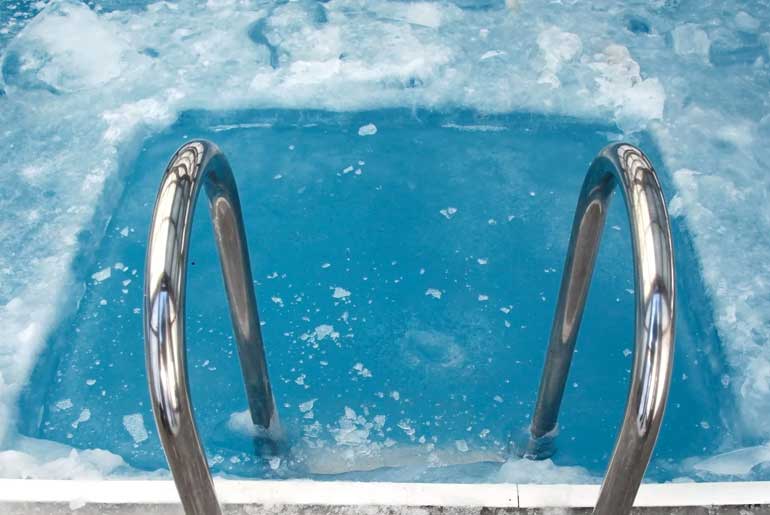The trend of ice bath, embraced by celebrities and fitness enthusiasts alike, involves immersing oneself in ice-cold water for a specified duration. She highlighted the challenge as being focused on deep breathing and listed various benefits, including improved immunity, cardiovascular health, muscle recovery, reduced inflammation, and an invigorating experience.
Fitness expert explains that cold exposure, such as an ice bath, can impact inflammation and muscle soreness. The constriction of blood vessels during cold exposure may limit the influx of immune cells and reduce the production of inflammatory substances, making ice baths a popular post-exercise recovery strategy.
Taking an ice bath, also known as cold water immersion or cryotherapy, involves immersing your body in cold water, typically with ice or very cold water added. This practice is often used by athletes and individuals seeking muscle recovery or other potential health benefits. Here’s what generally happens when you take an ice bath:
- Vasoconstriction: The cold temperature of the water causes blood vessels near the surface of your skin to constrict or narrow. This is known as vasoconstriction. The goal is to reduce blood flow to the extremities and redirect it to the core of the body.
- Reduction of Inflammation: Cold exposure may help reduce inflammation and swelling. This is particularly beneficial for athletes who engage in intense physical activities, as it may aid in the recovery of muscles and joints.
- Pain Relief: Cold therapy can have a numbing effect, providing temporary relief from pain and soreness. It may help alleviate muscle soreness and discomfort associated with intense exercise.
- Muscle Recovery: Ice baths are commonly used by athletes to expedite muscle recovery after strenuous workouts. The cold temperature is believed to help minimize muscle damage and speed up the healing process.
- Metabolic Rate Changes: Exposure to cold can lead to an increase in metabolic rate as the body works to generate heat. This temporary boost in metabolism may contribute to calorie burning.
- Release of Endorphins: Cold exposure can stimulate the release of endorphins, the body’s natural feel-good hormones. This can lead to a sense of well-being and improved mood.
- Improved Circulation: While there is initial vasoconstriction, prolonged exposure to cold may trigger a later stage of vasodilation, where blood vessels expand. This can enhance blood circulation and nutrient delivery to tissues once the body starts to warm up again.
- Potential Anti-Inflammatory Effects: Cold exposure has been associated with anti-inflammatory effects, which can be beneficial in managing inflammatory conditions or injuries.
It’s important to note that while ice baths can have potential benefits, they are not suitable for everyone, and there are some considerations:
- Duration: Prolonged exposure to very cold water can increase the risk of hypothermia or other adverse effects.
- Individual Variability: Responses to cold therapy can vary among individuals, and what works for one person may not work as well for another.
- Medical Conditions: Individuals with certain medical conditions, such as cardiovascular issues, should consult with a healthcare professional before attempting cold water immersion.
It’s advisable to approach ice baths with caution and, if uncertain, consult with a healthcare professional or sports medicine specialist to determine if it’s suitable for your specific situation and needs.
Additionally, the physiological response to cold exposure includes the release of stress hormones like adrenaline, which may improve circulation, increase alertness, and stimulate the production of endorphins—neurotransmitters associated with pain relief and well-being. As a result, individuals incorporating ice baths into their routine might experience mood elevation and enhanced recovery.
However, the benefits and risks of ice baths can vary among individuals. Factors such as age, fitness level, and overall health should be considered, and caution is advised for those with certain medical conditions. Alternatives like contrast baths, involving alternating between cold and warm water, are explored by individuals seeking recovery benefits with less intensity.
The duration of an ice bath is crucial in balancing potential benefits with associated risks. An optimal duration of around 10 to 15 minutes is recommended, as exceeding this timeframe may pose concerns such as increased cardiovascular risk, frostbite, and adverse effects on recovery. Following guidelines, monitoring physical responses, gradual acclimatization for newcomers, and adopting an individualized approach are key considerations for a safe and effective ice bath experience.
In summary, while ice baths offer potential benefits for recovery, it’s essential to strike a balance, be mindful of individual factors, and adhere to recommended guidelines to optimize efficacy and safety.
Disclaimer:
The information contained in this article is for educational and informational purposes only and is not intended as a health advice. We would ask you to consult a qualified professional or medical expert to gain additional knowledge before you choose to consume any product or perform any exercise.








